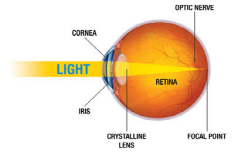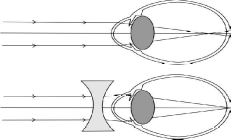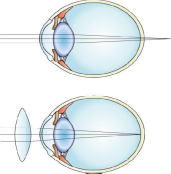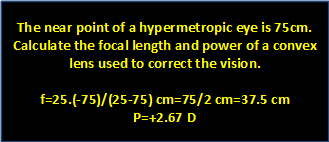Functions and Defects of Human Eye
How do we see?
- First step: The first step of vision is the entry of light after getting reflected from the object. Light enters our eye through the transparent structures (aqueous chamber, cornea, lens, vitreous chamber) of the eye.
- Second step: In the second step, the light rays get converged by the curvature of the cornea first and finally by the lens. As a result, an image is formed in the retina.
- Third step: The chemical changes are introduced in the rod and cone cells and an impulse through the nerve reaches the optical area of brain. Then brain interprets image we see upright.

Interesting facts about the human eye:
- Right eyes can see whatever falls in the blind spot of left eye and vice-versa. So, we get the complete vision by both the eyes.
- Human eyes can estimate the distance of the object being viewed.
- Any image formed in the retina persists for 1/16th of a second.
- If two images are flashed in front of human eyes in less than 1/16th of a second, they cannot be distinguished and seems to be in motion.
- In past, movie films were made by a series of still photographs taken at very short intervals of time. Those photographs were being flashed at 24 photographs per second. The result was the movie.

Common Defects Of Eye:
- Myopia
- Myopia is also known as near or short sightedness.
- In this defect, near objects are seen clearly but the distant objects are not.
- Malnutrition or inability of the ciliary muscles to relax completely leads to myopia.
- Myopia can be corrected by concave or diverging lens.
- Power of glasses used in myopia is popularly known as minus power.
Focal Length And Power Of The Concave Lens Used To Correct Myopia:
- The concave lens that corrects myopia diverge the rays entering the eye.
- Let the distance of an object from a myopic eye is ∞ and the far point of the myopic eye is d.
- Then u=-∞ and v=-d
- So, from thin lens formula we get f=-d (negative)
- Thus power P=100/-d (negative)

- Hypermetropia
- Hypermetropia is also known as far or long-sightedness.
- In this defect, there is difficulty in seeing near objects.
- This is caused by the shortening of the eyeball or flattening of the lens.
- Weakening of the ciliary muscles, old age or poor life style are the possible reasons.
- This defect can be corrected by using convex lens.
- Power of glasses used in Hypermetropia is popularly known as plus power.
Focal length and Power of the concave lens used to correct Hypermetropia:
- The convex lens that corrects Hypermetropia converge the rays entering the eye.
- Let the distance of an object from a hypermetropic eye is 25 (least sight) and the image formed due to the lens at a distance d
- Then u=-25 and v=-d
- So, from thin lens formula we get f=25.(-d)/(25-d)
- Thus power P=100/f


- Presbyopia
- The power of accommodation of the eye usually decreases with ageing. For most people, the near point gradually recedes away. They find it difficult to see nearby objects comfortably and distinctly without corrective eye-glasses. This defect is called Presbyopia.
- In this defect, there is difficulty in seeing both near and far objects.
- Due to ageing, ciliary muscles are weakened, this causes presbyopia.
- It can be corrected by using bi-focal lenses.
- Bi-focal lenses are combination of concave and convex lens.
- Cataract
- Sometimes, the crystalline lens of people at old age becomes milky and cloudy. This condition is called cataract.
- As a result, the vision is completely or partially impaired.
- If untreated, it may cause blindness.
- Now days, this defect is corrected by surgically implanting a plastic lens behind or in front of the iris. This is known as Phacoemulsification.

About Author: Sajid Mostaque has total work experience of 3 years in corporate world. He is a Program Implementation Associate. He is working with STEM Learning from last 9 months.
stem-learning
0
Tags :

